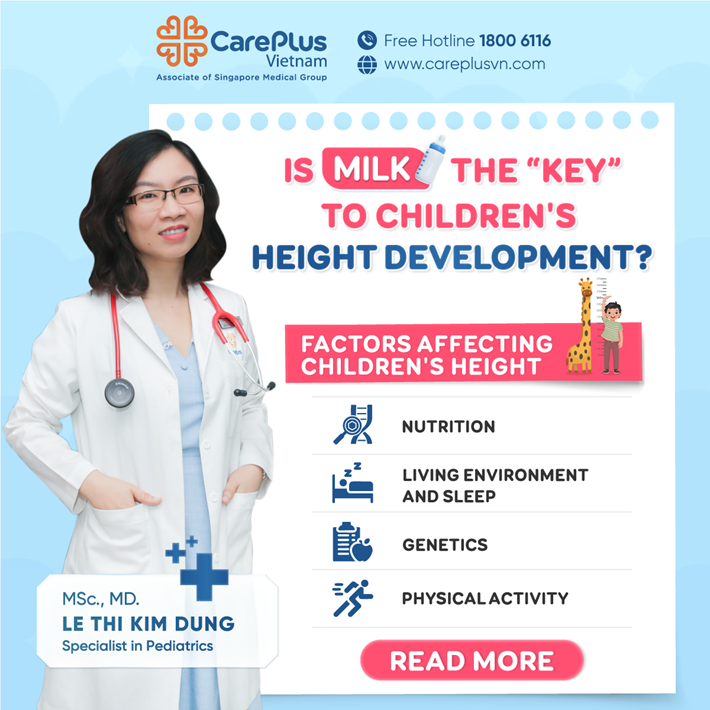IS MILK THE “KEY” TO A CHILD’S HEIGHT DEVELOPMENT?

4/29/2025 11:28:51 AM
Many parents dream of their children having an ideal height, often wondering: “What kind of milk should my child drink to grow taller?” However, height growth is not determined by milk alone. It is a combination of various factors, including genetics (60–80%), nutrition, physical activity, living environment, and overall health.
Let’s explore the key factors that support optimal height development in children with MSc, MD Lê Thị Kim Dung, Pediatric Specialist at the CarePlus Clinic System.
1. Nutrition – The Golden Foundation for Height Growth
Numerous studies have shown that nutrition plays a critical role in children’s height development. For continuous height gain, children need to consume adequate daily energy. Only when children gain sufficient weight can they grow taller. Besides caloric intake, several micronutrients have been scientifically proven to support height growth, including Vitamin A, Vitamin D, lysine, calcium, iron, zinc, and iodine.
1.1. Vitamin D
Vitamin D enhances the absorption of calcium and phosphorus—two vital minerals that form bone structure. A deficiency in vitamin D can result in growth retardation and rickets.
Recommended daily intake by age:
- Infants under 12 months: 10 mcg (400 IU)
- Children 1–18 years old: 15 mcg (600 IU)
1.2. Vitamin A
Vitamin A supports cellular and bone growth and boosts immunity, helping children stay healthier and thereby grow more consistently in height.
1.3. Calcium
Calcium is the most essential mineral for bone development and building a strong skeletal frame.
Recommended daily calcium intake by age:
- <6 months: 300 mg/day
- 7–12 months: 400 mg
- 1–3 years: 500 mg
- 4–6 years: 600 mg
- 7–9 years: 700 mg
- 10 years: 1,000 mg
- 11–18 years: 1,200 mg
1.4. Zinc
Zinc plays a role in protein synthesis, cell division, and overall growth. Zinc deficiency is often linked to poor appetite, stunted growth, and a higher risk of developmental delays.
1.5. Iodine
Iodine is essential for thyroid function, which regulates metabolism and growth. Insufficient iodine can impair physical and cognitive development.
2. Adequate Sleep – The Secret to Growing Taller During Rest
Sleep, especially nighttime sleep, is crucial because growth hormone (GH) is secreted the most between 11 PM and 2 AM, during deep sleep. Children who sleep late or don’t get enough rest may experience reduced GH production, negatively impacting their height growth.
Parents should aim to put children to bed before 10 PM to maximize growth hormone secretion.
3. Physical Activity & Living Environment – Two Key Factors for Height Growth
In addition to nutrition and sleep, regular physical activity is a major contributor to height development. Exercises like swimming, running, cycling, jump rope, and pull-ups help stretch muscles and bones while stimulating growth hormone production.
Conversely, children who live in polluted environments, lead sedentary lifestyles, are frequently ill, or are kept indoors too much may struggle to reach their full height potential.
4. The 3 “Golden Windows” That Determine a Child’s Future Height
Height doesn’t grow at a steady rate but experiences significant spurts during the following three critical stages:
- Fetal stage:
If a pregnant mother lacks proper nutrition and the fetus is born underweight or with low birth length, the child may have difficulty catching up to the standard height later on.
- .Ages 0–2 years:
This is the fastest growing period. Malnutrition, especially stunting, during this phase increases the risk of short stature in adulthood.
- Pre-puberty & puberty (Girls: 10–13 years, Boys: 13–16 years):
This is a period of accelerated height growth. With proper nutrition and physical activity, children can make significant gains, sometimes even exceeding their genetic potential.
Therefore, according to MSc, MD Lê Thị Kim Dung, height development is not solely dependent on drinking milk. While milk is an important source of calcium—especially breast milk, which offers superior calcium absorption compared to cow’s milk—milk alone is not enough.
After weaning, children should be given age-appropriate formula or fresh milk, combined with a balanced diet and regular physical activity to achieve optimal height growth.